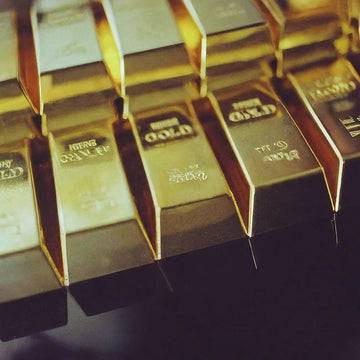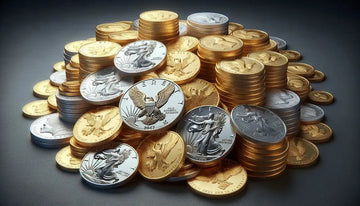Introduction: The Evolving Landscape of Gold Bullion Collection
Gold isn’t just a metal; it’s a legacy that has seen the test of time, morphing from a currency to a symbol of wealth, and now to a collector’s dream. The allure of gold bullion remains unshaken in the eyes of collectors, yet the playing field is changing. The rise of digital gold, advancements in security features, and the ever-present debate on gold’s role in a modern portfolio are redefining what it means to be a bullion collector in today’s world. Understanding these shifts is more than just keeping up; it’s about staying ahead. Whether you’re a seasoned collector or just dipping your toes in the golden waters, grasping the evolving landscape of gold bullion collection is crucial. It’s not about hoarding; it’s about making informed decisions with a metal that has captivated humanity for millennia. Stay tuned, as we navigate through these changes together, ensuring that your collection not only retains its value but also its relevance in the future.
The Historical Significance of Gold Bullion
Gold has been a symbol of wealth and power since ancient times. Kings and empires hoarded gold to show their dominance. This precious metal wasn’t just for show; it backed currencies for centuries, making it a cornerstone of stable economies. The Gold Standard, used worldwide until the 20th century, tied the value of money directly to gold. This link ensured that a country’s currency had a fixed value in terms of gold, promoting global trade and investment reliability. Even though modern currencies have moved away from being directly backed by gold, its historical importance continues to influence its value and desirability among collectors and investors. Gold bullion, bars, and coins are tangible links to this rich history, representing not just wealth but the enduring power of gold as a symbol through ages.
Recent Trends in Gold Bullion Prices
Gold prices are always on the move, and keeping up with these changes is vital for any bullion collector. Recently, we’ve seen gold prices swing due to global economic uncertainties, shifts in currency values, and changes in central bank policies. Generally, when the economy looks unsure, people tend to invest more in gold, driving the prices up. On the flip side, when economic stability improves, gold prices can dip as investors move their funds to other assets. Also, when the dollar strengthens, gold prices usually fall since gold is priced in dollars. Understanding these trends can help you make smarter decisions about when to buy or sell your gold. Stay informed, watch the global economy, and always be ready to act when the time feels right.
Technological Advancements Impacting Gold Bullion Collection
Gold has always held a special place in the hearts of collectors and investors alike. But the way we collect, authenticate, and value gold is rapidly changing, thanks to technology. Digital innovations are making it easier and more secure to own gold. For instance, blockchain technology now allows for the creation of digital gold tokens, representing real gold stored securely in vaults. This means you can own gold without worrying about storage or security. Another breakthrough is the use of advanced scanning techniques to authenticate gold bars and coins, ensuring they are not counterfeit. This adds an extra layer of confidence for collectors. Moreover, online platforms have transformed the accessibility of gold bullion, enabling collectors to buy and sell with ease globally. These advancements are not just changing the game; they’re making gold collection more accessible, secure, and verifiable than ever before.
The Role of Central Banks in the Future of Gold
Central Banks play a big role in the future of gold. They hold large amounts of gold as part of their foreign exchange reserves. When these banks buy more gold, the price often goes up because it shows they believe in gold as a stable investment. If they sell, it can cause the price to drop. The World Gold Council says that these banks have been net buyers of gold for many years now. This trend is key to understanding gold’s future. Their actions can also reflect how they view global economic stability. So, if you’re a bullion collector, keep an eye on what the central banks are doing. Their moves can give you hints about where gold prices might be headed.
How Economic Factors Influence Gold Bullion Valuation
Let’s get straight to the point. Gold isn’t just shiny; it’s smart. Your gold’s value dances with the economy’s rhythm. When stocks tumble, gold often glints brighter, offering a safe haven. Why does this happen? Three big economic dancers affect your gold’s groove: inflation, currency values, and interest rates. When inflation kicks in, your cash buys less, but gold? It stands strong, often even gaining value. A weakening dollar makes gold cheaper for buyers using stronger currencies, pushing gold prices up. Now, interest rates play a tricky tune. High rates can dim gold’s appeal because gold doesn’t pay interest. Yet, in low-interest times, gold shines as a star performer. Remember, gold’s value isn’t just about market moves; it’s about economic resilience. Keep an eye on these factors, and you’re not just collecting gold; you’re mastering an economic ballet.
The Rise of Digital Gold and Cryptocurrency
Gold isn’t just bars and coins anymore. The digital age has given birth to what many call digital gold and cryptocurrencies, reshaping how we view this precious metal. Digital gold allows investors to own physical gold without the hassle of storage or security concerns. You buy online, and a company stores it for you, safe and sound. Now, let’s talk cryptocurrency. This digital currency emulates gold’s scarcity through complex algorithms, with Bitcoin being the poster child. Unlike traditional gold, you can transfer cryptocurrencies across the globe in seconds, without hefty fees or middlemen. The rise of digital gold and crypto doesn’t mean physical gold has lost its charm. Rather, it’s a sign that gold’s legacy is evolving, blending tradition with innovation. This transformation is not just exciting; it’s revolutionizing how bullion collectors and investors approach the asset, presenting new opportunities to diversify and secure wealth in the digital era.
Sustainable and Ethical Gold Mining Practices
Gold mining has a notorious history for its environmental and ethical issues. But here’s the twist – the industry is changing. Today, there’s a strong push for sustainable and ethical gold mining practices. Why does it matter? Because it’s not just about digging gold out of the earth anymore. It’s about doing it in a way that harms neither the planet nor the people.
Sustainable mining methods focus on reducing environmental impact. This includes using less water, less energy, and producing fewer emissions. It’s all about being gentle on our planet while still getting that precious gold.
On the ethics side, it’s crucial that the gold on your shelf doesn’t come with a backstory of human rights abuses. Ethical gold mining ensures fair treatment and pay for the miners. It also fights against child labor and ensures that local communities benefit rather than suffer from the mining activities.
In summary, the future of gold looks bright – but only if mined responsibly. As a collector, choosing gold from sources that prioritize sustainability and ethics does more than just add a shine to your collection; it supports a healthier planet and fairer societies. So, next time you’re eyeing a new piece for your collection, remember the power of responsible choice.
Tips for New Collectors Entering the World of Gold Bullion
Starting your journey into gold bullion collecting can feel like stepping into a maze—exciting but complex. Here are no-nonsense tips to guide you through. First, educate yourself about gold. Before spending a penny, understand what makes gold valuable and the differences between coins, bars, and other forms. Websites, books, and forums can be gold mines of information. Next, buy from reputable dealers. With scams aplenty, trust is key. Look for dealers with good reviews and proper credentials. Consider both local shops and online platforms, but do your homework. Start small. No need to splash out huge sums immediately. Begin with smaller investments to learn the ropes without risking too much. Diversify your collection. Don’t put all your eggs in one basket. Mix it up with coins, bars, and maybe even gold jewelry to understand different market values. Understand the market. Gold prices swing. Knowing when to buy and sell is an art that comes with time and experience. Following market trends will help you make informed decisions. Lastly, be patient. Building a valuable collection doesn’t happen overnight. It’s a marathon, not a sprint. Happy collecting!
Projections: The Long-Term Outlook for Gold Bullion Collectors
Predicting the future of gold prices is challenging, as the market is influenced by various global factors. However, experts often look at long-term trends, economic indicators, and geopolitical scenarios to make educated guesses. Generally, the outlook for gold bullion collectors appears promising for several reasons. First, gold traditionally maintains its value over time, acting as a hedge against inflation. This means when the value of money decreases, gold’s value often goes up. Secondly, during times of economic uncertainty or geopolitical tension, investors flock to gold as a safe haven, which can drive prices up. Lastly, as the global economy grows, demand from industries that use gold, like electronics and jewelry, could push its value higher. While it’s hard to pin down exact numbers, the long-term trajectory for gold seems to point upwards. Remember, investing in gold should be part of a diversified strategy, considering it’s subject to market fluctuations like any other asset.






